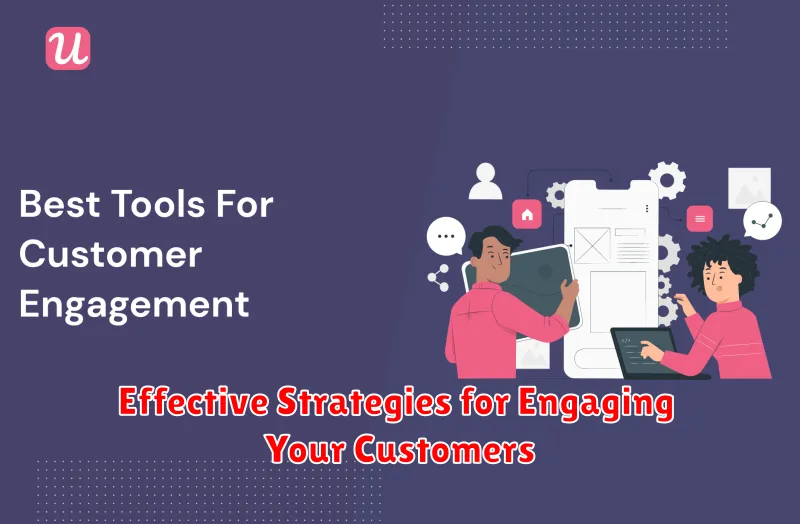In today’s competitive market, engaging customers is paramount to success. Customer engagement drives customer loyalty, increases customer lifetime value, and fuels business growth. This article explores effective strategies for engaging your customers, providing actionable insights to cultivate strong relationships and foster a thriving community around your brand. From understanding your customer base to leveraging the right communication channels, we’ll delve into the key elements of a successful customer engagement strategy.
Discover how to create meaningful interactions that resonate with your customers. We’ll examine various tactics, including personalized communication, interactive content, and loyalty programs, to boost customer engagement and maximize your return on investment. Learn how to transform casual consumers into brand advocates by implementing these effective strategies and building genuine connections. Whether you’re a small business or a large enterprise, mastering the art of customer engagement is essential for sustainable growth and lasting success in today’s dynamic business landscape.
Understanding Customer Expectations
Customer expectations are the beliefs about service delivery that serve as standards or reference points against which performance is judged. Meeting and exceeding these expectations is crucial for business success. Customers form expectations based on a variety of factors, including past experiences, word-of-mouth referrals, marketing messages, and competitor offerings. Understanding these influences allows businesses to proactively shape and manage customer perceptions, ultimately leading to increased customer satisfaction and loyalty.
There are two primary types of customer expectations: desired service and adequate service. Desired service represents the ideal level of service a customer hopes to receive. Adequate service, on the other hand, signifies the minimum level of service deemed acceptable. The gap between these two levels reflects the customer’s zone of tolerance. Effectively managing this zone is critical, as consistently exceeding adequate service while striving towards desired service builds strong customer relationships.
Accurately identifying and addressing customer expectations requires ongoing effort. Businesses should actively solicit customer feedback through surveys, reviews, and direct interactions. Analyzing this feedback reveals valuable insights into customer needs and preferences. This information can then be used to refine service delivery, improve product offerings, and enhance overall customer experience. By consistently monitoring and adapting to evolving customer expectations, businesses can position themselves for sustainable growth and competitive advantage.
Using Personalized Communication
Personalized communication tailors messages to individual recipients, leveraging data about their preferences, behaviors, and demographics. This approach aims to foster stronger connections by delivering relevant content and offers, ultimately increasing engagement and boosting conversion rates. By understanding the specific needs and interests of each individual, businesses can craft messages that resonate more deeply and effectively.
Implementing personalized communication involves several key steps. First, data collection is crucial. This may involve gathering information from website interactions, purchase history, surveys, and other sources. Next, data analysis helps to segment audiences based on shared characteristics. Finally, crafting tailored messages for each segment ensures that the content is relevant and appealing to the specific recipient. Effective personalization requires careful consideration of tone, language, and offers to maximize impact.
The benefits of personalized communication are numerous. Increased customer satisfaction, higher conversion rates, and improved brand loyalty are among the most significant advantages. Additionally, personalization can drive repeat business, reduce marketing costs by targeting efforts more effectively, and enhance overall brand perception. Ultimately, using personalized communication can lead to stronger, more valuable customer relationships and contribute significantly to business growth.
Leverage Social Media Responsively

Social media offers unparalleled opportunities for businesses to connect with their target audience, build brand awareness, and drive sales. Responsibly leveraging these platforms requires a strategic approach. This involves understanding your audience, crafting engaging content, and actively monitoring and responding to interactions. It also necessitates a commitment to ethical practices, including transparency and respecting user privacy. A well-defined social media strategy can significantly enhance your overall marketing efforts.
Responsive social media management goes beyond simply posting content. It requires actively listening to your audience, addressing their concerns, and participating in relevant conversations. This fosters a sense of community and builds trust. Monitoring social media for mentions of your brand, both positive and negative, is crucial. Promptly addressing negative feedback or criticisms can mitigate potential damage and demonstrate your commitment to customer satisfaction. Analyzing social media data can provide valuable insights into audience behavior and preferences, informing future content strategy.
Developing a responsive social media presence takes time and consistent effort. Key components include: establishing clear goals and objectives, identifying your target audience, creating a content calendar, choosing the right platforms, and regularly analyzing your performance. By adhering to these principles and remaining adaptable to the ever-evolving social media landscape, businesses can effectively leverage these platforms to achieve their marketing objectives and cultivate meaningful relationships with their customers.
Create Loyalty Programs That Work
Effective loyalty programs drive repeat business and foster strong customer relationships. They should be designed with a clear understanding of your target audience and their preferences. Focus on offering valuable rewards that resonate with your customers, whether it’s exclusive discounts, early access to new products, or personalized experiences. Simplicity is key; complicated programs can deter participation. Ensure the program is easy to understand, join, and redeem rewards.
Consider different program structures. Points-based systems are popular and allow customers to accumulate points for purchases, which can be redeemed for rewards. Tiered programs offer escalating benefits based on spending levels, encouraging increased engagement. Paid membership programs, while requiring an upfront fee, can provide premium benefits like free shipping, exclusive content, or dedicated customer support. Choose the structure that best aligns with your business goals and customer expectations.
Regularly evaluate and refine your loyalty program. Track key metrics such as participation rates, redemption rates, and customer feedback to identify areas for improvement. Staying flexible and adapting to changing customer needs is crucial for long-term success. Promote your program effectively to ensure customers are aware of its benefits and how to participate.
Ask for Feedback and Act on It
Feedback is crucial for growth, both personally and professionally. Don’t be afraid to actively solicit feedback from colleagues, supervisors, clients, or even friends and family. Ask specific questions to get the most valuable insights. For example, instead of asking “How am I doing?”, try “What could I have done differently in that presentation to make it more engaging?” or “What’s one area where you see the most opportunity for me to improve?”
Once you’ve received feedback, take the time to carefully consider it. Even critical feedback can be constructive if you approach it with an open mind. Thank the person who provided the feedback, and if you’re unsure about anything, ask clarifying questions. Don’t become defensive or dismissive; the goal is to learn and grow.
Finally, and most importantly, act on the feedback you receive. Develop a plan to implement suggested changes and track your progress. This demonstrates that you value the input and are committed to improvement. Share your progress with those who gave you feedback, letting them know how their input has helped you. This closes the loop and encourages ongoing, open communication.
Gamification and Interactive Content
Gamification integrates game mechanics into non-game contexts to enhance engagement and motivation. It leverages elements like points, badges, leaderboards, challenges, and rewards to encourage specific behaviors and create a more interactive experience. By tapping into our natural competitiveness and desire for achievement, gamification can make learning, working, or even everyday tasks more enjoyable and productive.
Interactive content goes beyond passive consumption and invites active participation. This can take many forms, such as quizzes, polls, calculators, interactive infographics, and even 360-degree videos. By allowing users to interact directly with the content, they become more invested and retain information more effectively. This personalized experience leads to a deeper understanding and a more memorable encounter with the material.
When combined, gamification and interactive content create a powerful synergy. Interactive elements can be gamified to further encourage participation, while gamification can provide a framework and motivation for engaging with interactive content. This dynamic approach can significantly boost engagement, knowledge retention, and overall user satisfaction.
Build a Community Around Your Brand
Building a community around your brand fosters loyalty and drives growth. It transforms casual customers into passionate advocates who actively engage with your brand and spread the word to their networks. This organic promotion is invaluable, creating a sense of belonging and shared values that strengthens your brand’s identity.
Start by identifying your target audience’s shared interests and values. Create a platform where they can connect with each other and your brand. This could be a dedicated online forum, social media group, or even in-person events. Encourage interaction and two-way communication. Respond to comments and questions, run contests, and highlight user-generated content. Focus on building genuine relationships rather than just pushing sales.
Remember to constantly nurture your community. Provide valuable content, offer exclusive perks, and solicit feedback regularly. Showing that you value their input and appreciate their participation creates a strong sense of community and encourages continued engagement. This fosters long-term brand loyalty and builds a powerful network of advocates who contribute to your brand’s success.
Engage With Timely Customer Support
Excellent customer service hinges on timely support. Customers value quick responses and efficient solutions to their issues. Providing support in a timely manner demonstrates respect for their time and fosters a sense of trust and loyalty. This can lead to increased customer satisfaction and positive word-of-mouth referrals.
Several strategies can improve response times. These include implementing a robust ticketing system, utilizing live chat software, and empowering support staff to resolve common issues quickly. Regularly analyzing support interactions and identifying common customer pain points can also help streamline the support process and minimize resolution times.
Ultimately, timely customer support is a key differentiator in today’s competitive landscape. By prioritizing quick and effective responses, businesses can build strong customer relationships, increase retention, and drive overall success.
Monitor Customer Engagement Metrics
Monitoring customer engagement metrics is crucial for understanding how customers interact with your brand and identifying areas for improvement. These metrics provide valuable insights into customer behavior, allowing businesses to make data-driven decisions to optimize marketing campaigns, product development, and overall customer experience. By tracking key metrics, businesses can identify trends, understand customer preferences, and ultimately, drive business growth.
Key customer engagement metrics to monitor often include website traffic, conversion rates, social media engagement (likes, shares, comments), email open and click-through rates, customer satisfaction scores (CSAT), and Net Promoter Score (NPS). Analyzing these metrics can reveal valuable information about customer loyalty, product effectiveness, and the success of marketing initiatives. Regularly monitoring these metrics helps businesses stay informed about customer behavior and allows for proactive adjustments to strategies.
By actively monitoring and analyzing customer engagement metrics, businesses can improve customer satisfaction, increase customer lifetime value, and boost overall business performance. Understanding how customers interact with your brand empowers you to make informed decisions that foster stronger customer relationships and drive sustainable growth.
Evolve Based on Behavioral Data
Using behavioral data to drive evolution in product development or business strategy offers a powerful advantage. By analyzing how users interact with your product, platform, or service, you gain valuable insights into their needs, preferences, and pain points. This data, collected through various methods like A/B testing, user surveys, and website analytics, can inform critical decisions, leading to more effective iterations and improvements.
The iterative process of evolution based on behavioral data involves continuous monitoring, analysis, and adaptation. Gathering data, interpreting trends, and implementing changes based on these findings creates a feedback loop that fuels ongoing development. This data-driven approach ensures that updates and new features are aligned with actual user behavior, rather than assumptions or guesswork. This leads to increased user engagement, higher conversion rates, and a more user-centric product or service.
By prioritizing behavioral data, businesses can not only improve existing offerings but also anticipate future needs. Identifying emerging patterns in user behavior allows for proactive development, enabling you to stay ahead of the curve and meet evolving customer expectations. This proactive stance strengthens market position and fosters sustainable growth by ensuring your product or service remains relevant and valuable to its users.

